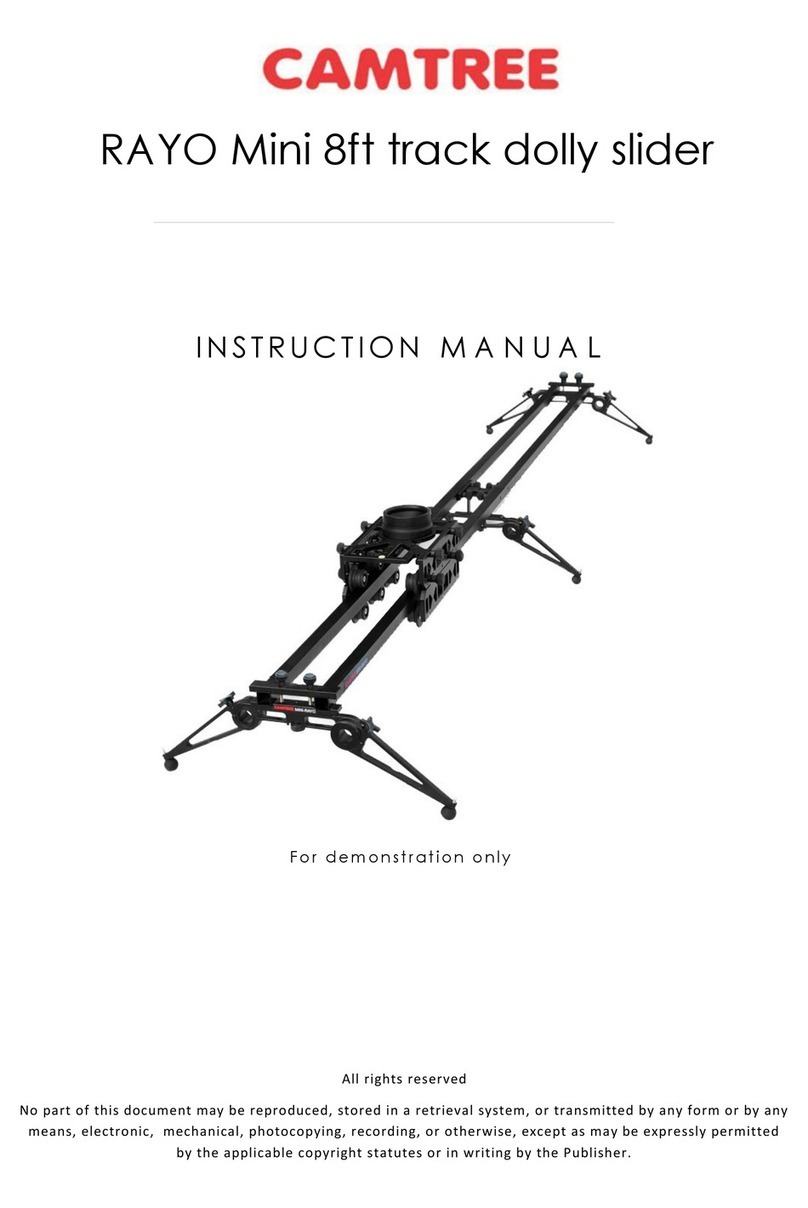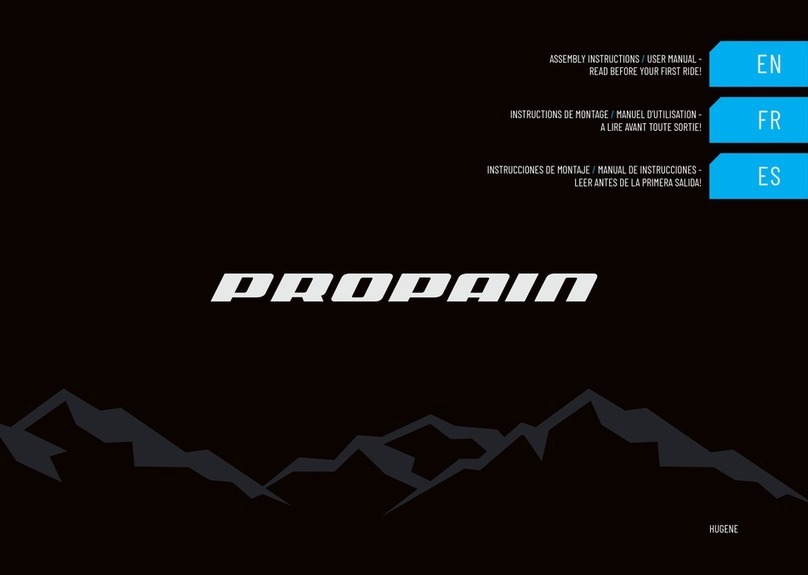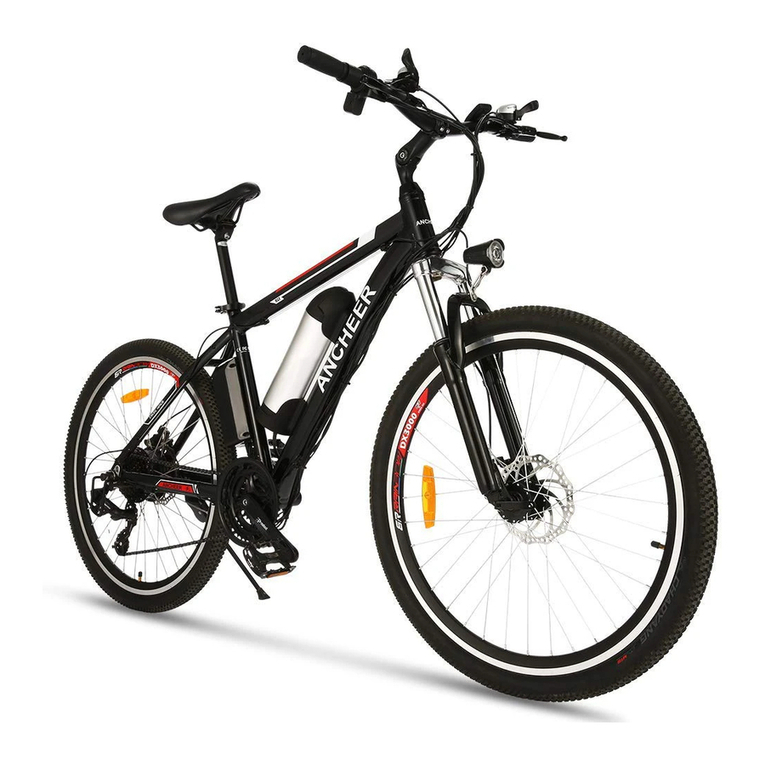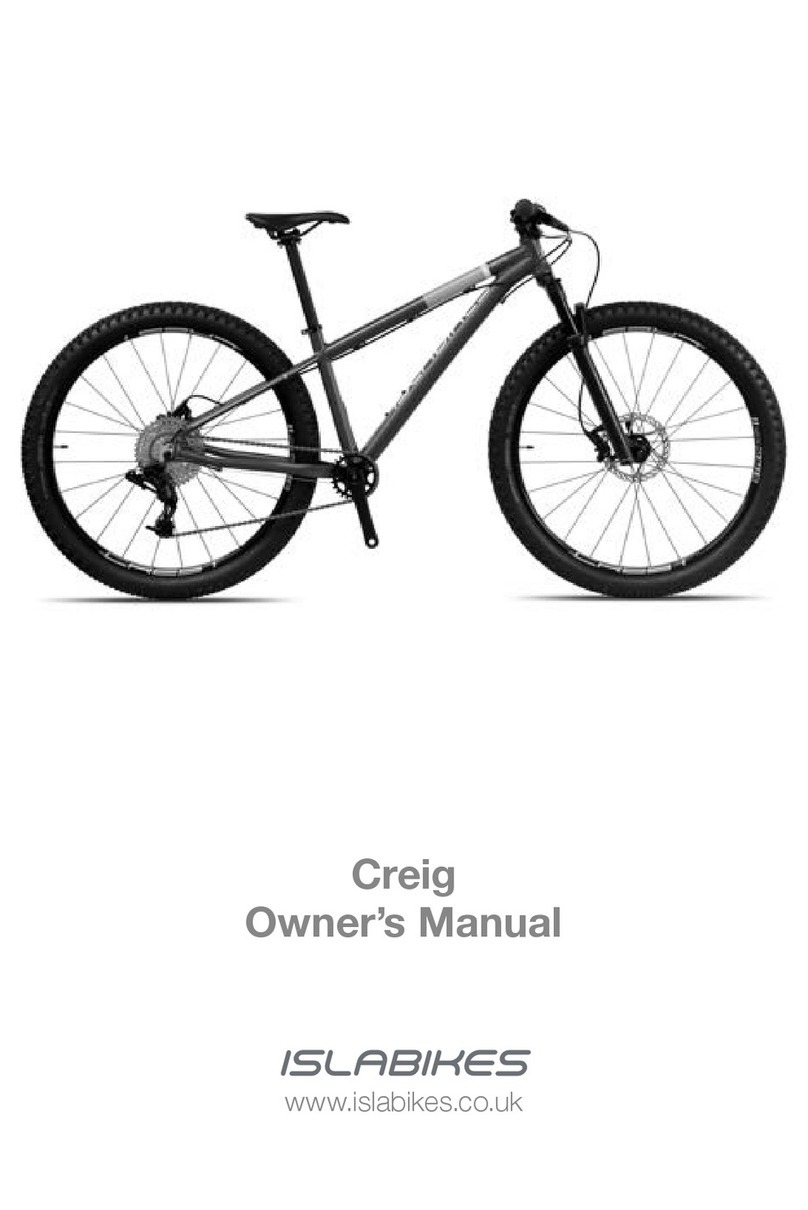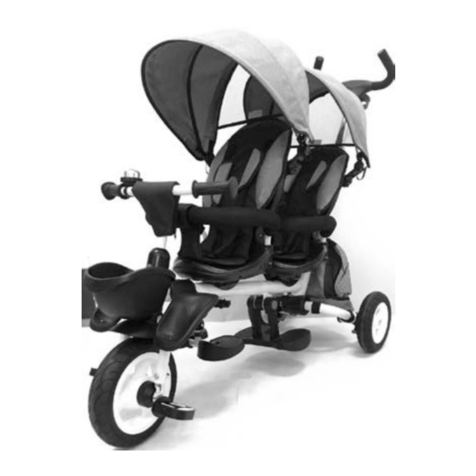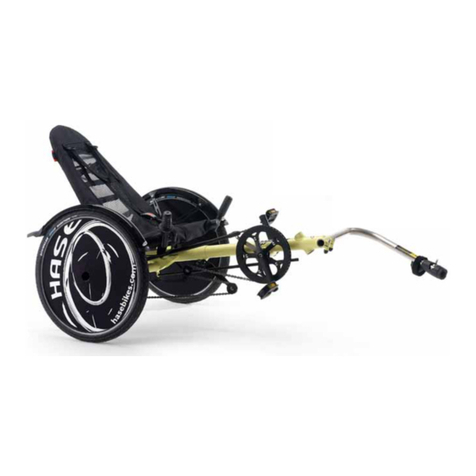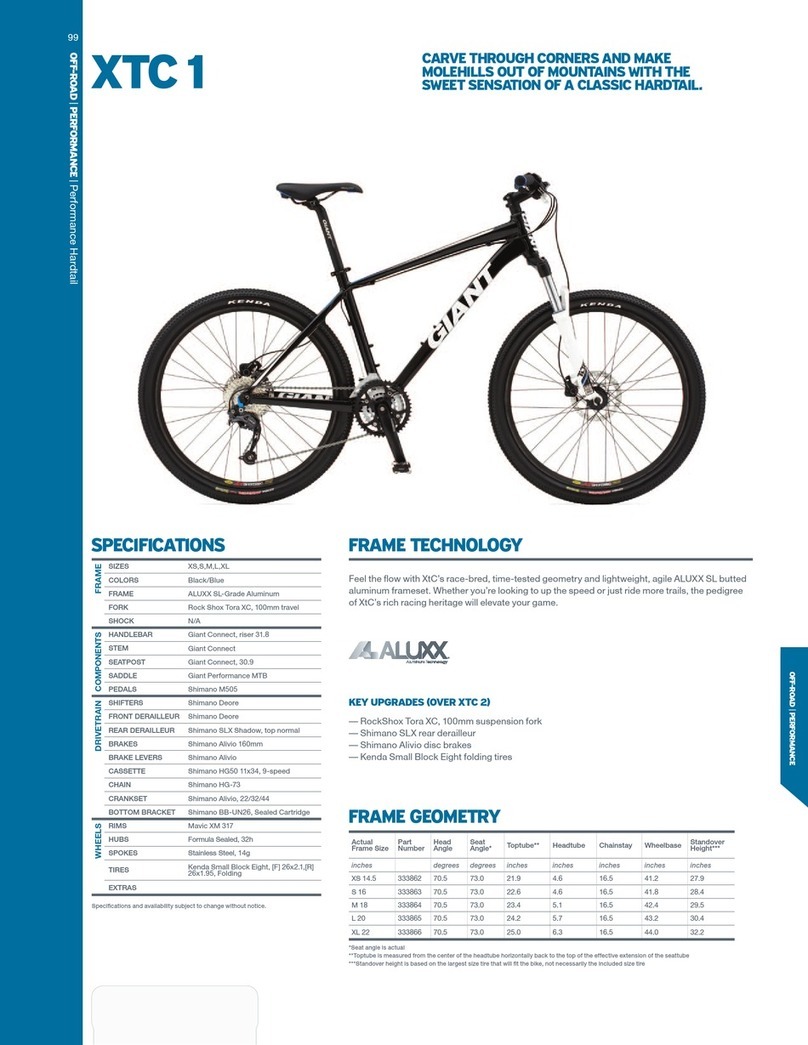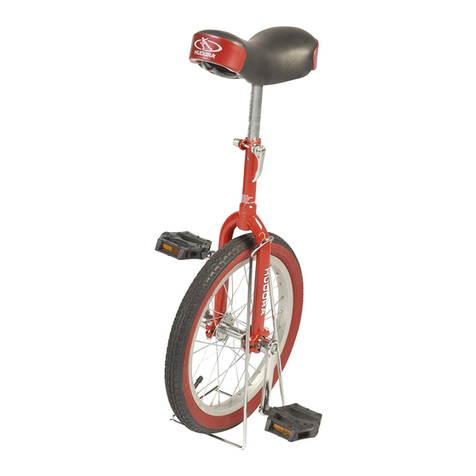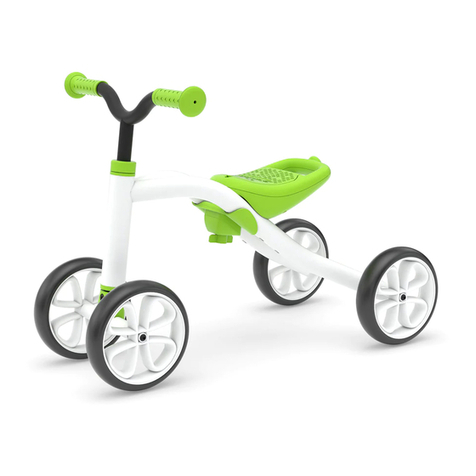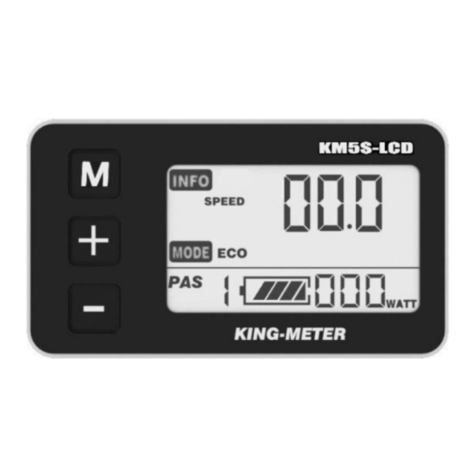MOZIE Hugo User manual


2 3
Congratulations on the purchase of your new MOZIE Bicycle. We’re
excited that you’ve chosen a MOZIE Bicycle to add a little style,
comfort, and enjoyment to your life. We truly believe your new MOZIE
will help you rediscover the joy of bicycling, and allow you to reconnect
with your surroundings in a simple and intimate way.
This document highlights the key function and safety features of
your new MOZIE bicycle. As with any cherished item, we suggest you
treat your MOZIE with care and concern. By protecting it from the
elements, working with your qualified local bicycle shop to perform
regular maintenance, and keeping it free of bumps, bruises, dings and
nicks, you can keep your MOZIE looking and riding like new for many
years to come.
Please contact us at any time if you have any questions or comments
regarding your MOZIE bicycle. You’re now part of the family!
Toll Free: 888.241.0837
Email: support@moziebicycles.com
LIFE IS BETTER WHEN YOU MOZIE!
INTRODUCTION
I. BICYCLE DIAGRAM 4
II. GENERAL WARNING 5
A. A Special Note to Parents 5
III. BICYCLE ASSEMBLY STEPS 6
IV. BEFORE YOU RIDE 10
A. Bicycle Fit 10
B. Safety First 10
C. Mechanical Safety Check 10
D. First Ride 12
V. SAFETY 13
A. The Basics 13
B. Riding Safety 13
C. O-road Safety 14
D. Wet Weather Riding 14
E. Night Riding 15
F. Changing Components or Adding Accessories 16
VI. FIT 17
A. Standover Height 17
A1. Diamond Frame Bicycles 17
A2. Step-through Frame Bicycles 17
B. Saddle Position 17
C. Handlebar Height and Angle 17
D. Control Position Adjustments 19
E. Brake Reach 19
VII. TECH 20
A. Wheels 20
B. Seat Post Bolt 22
C. Brakes 22
D. Shifting Gears 24
E. Pedals 25
F. Tires & Tubes 26
G. Seat & Grips 27
VIII. SERVICE 28
A. Service Intervals 28
B. If Your Bicycle Sustains An Impact 30
IX. APPENDIX A 31
Fastener Torque Specifications
X. APPENDIX B 32
Limited Warranty
CONTENTS

4 5
1. Wheel
2. Chain
3. Chain Ring
4. Pedal
5. Seat Post
6. Seat
7. Fender
8. Frame
9. Steering Tube
10. “Quill” Headset Stem
11. Handlebars
12. Handgrips
13. Brake Lever
14. Fork
15. Caliper Brakes
16. Front Roller Brake
(Marc Only)
17. Rear Roller Brake
18. Kickstand
19. Chain Guard
20. Crank arm
21. Internal Hub
22. Gear Shifter
23. Sprocket
24. Dropouts
I. BICYCLE DIAGRAM
Like any sport, bicycling involves risk of injury and damage. By choosing
to ride a bicycle, you assume the responsibility for that risk, so you need
to know — and to practice — the rules of safe and responsible riding and
of proper use and maintenance. Proper use and maintenance of your
bicycle reduces risk of injury.
This Manual contains many “Warnings” and “Cautions” concerning the
consequences of failure to maintain or inspect your bicycle and of
failure to follow safe cycling practices.
• The combination of the safety alert symbol and the word
WARNING indicates a potentially hazardous situation which, if not
avoided, could result in serious injury or death.
• The combination of the safety alert symbol and the word
CAUTION indicates a potentially hazardous situation which, if not
avoided, may result in minor or moderate injury, or is an alert against
unsafe practices.
• The word CAUTION used without the safety alert symbol indicates a
situation which, if not avoided, could result in serious damage to the
bicycle or the voiding of your warranty.
Many of the Warnings and Cautions say “you may lose control and fall”.
Because any fall can result in serious injury or even death, we do not
always repeat the warning of possible injury or death.
Because it is impossible to anticipate every situation or condition which
can occur while riding, this Manual makes no representation about the
safe use of the bicycle under all conditions. There are risks associated
with the use of any bicycle which cannot be predicted or avoided, and
which are the sole responsibility of the rider.
A. A special note for parents
As a parent or guardian, you are responsible for the activities and safety of
your minor child, and that includes making sure that the bicycle is properly
fitted to the child; that it is in good repair and safe operating condition;
that you and your child have learned and understand the safe operation of
the bicycle; and that you and your child have learned, understand and obey
not only the applicable local motor vehicle, bicycle and trac laws, but
also the common sense rules of safe and responsible bicycling. As a parent,
you should read this manual, as well as review its warnings and the bicycle’s
functions and operating procedures with your child, before letting your
child ride the bicycle.
WARNING: Make sure that your child always wears an approved
bicycle helmet when riding; but also make sure that your child understands
that a bicycle helmet is for bicycling only, and must be removed when not
riding. A helmet must not be worn while playing, in play areas, on playground
equipment, while climbing trees, or at any time while not riding a bicycle.
Failure to follow this warning could result in serious injury or death.
II. GENERAL WARNING
1
5
8
9
10
11
12 22
13
14
24
23
18
19
21
15
6
7
4
2
320
17
16

6 7
Your MOZIE bicycle comes directly to you 98% assembled. The
instructions will guide you through the additional steps necessary to
complete assembly. However, MOZIE Bicycles strongly suggests having
your bicycle assembled by a qualified bicycle mechanic or bicycle shop.
To help you find a qualified bicycle shop in your area give us a call at
888.241.0837 or email us at [email protected] We feel every
bicycle owner should have a knowledgeable and trusted bicycle shop to
assist with routine maintenance, repairs, additional safety equipment,
and to help maintain the safety and integrity of your MOZIE bicycle.
TOOLS NEEDED:
•Scissors or Box Cutter
•Adjustable wrench
•6mm hex Allen wrench - Included
•5mm hex Allen wrench - Included
•Flat wrench – Included
UNPACKAGING
• Open box, remove bicycle and parts box.
• Remove all packaging. Take care when cutting zip ties to not scratch
frame.
III.BICYCLE ASSEMBLY STEPS III. BICYCLE ASSEMBLY STEPS
PEDAL INSTALLATION
• Remove pedals from parts box. Check on the pedal axle to determine
which pedal is the right pedal and which pedal is the left pedal. The right
pedal will always be marked with an “R” on the axle. This goes on the
right side of the bike, the side with the chain.
• Using your hand, begin threading the right pedal into the right crank
arm by turning the pedal axle CLOCKWISE (Fig. 1). Once the pedal
threads are engaged (ensuring no cross-threading), use the included flat
wrench to tighten right pedal to the specified tightness (350kgf/cm2).
• Using your hand, begin threading the left pedal into the left crank
arm by turning the pedal axle COUNTER- CLOCKWISE. Once the pedal
threads are engaged (ensuring no cross-threading), use the included flat
wrench to tighten the left pedal to the specified tightness (350kgf/cm2).
SEAT AND SEATPOST ADJUSTMENT
Your seat and seat post have been attached to the bike. Correct seat
adjustment is an important factor in getting the most performance and
comfort from your bicycle. If the seat position is not comfortable for
you, see your qualified local bicycle shop. The seat can be adjusted in
three directions: height adjustment; front to back adjustment, and seat
angle adjustment
SEAT HEIGHT
1. Up and down adjustment.
To check for correct saddle height:
• sit on the saddle
• place one heel on a pedal
• rotate the crank until the pedal with your heel on it is in the down
position and the crank arm is parallel to the seat tube.
If your leg is not completely straight, your saddle height needs to be
adjusted. If your hips must rock for the heel to reach the pedal, the
saddle is too high. If your leg is bent at the knee with your heel on the
Fig. 1

8 9
III. BICYCLE ASSEMBLY STEPS
pedal, the saddle is too low.
Ask your qualified local bicycle shop to set the saddle for your optimal
riding position and to show you how to make this adjustment. If you
choose to make your own saddle height adjustment:
•Using the included 5mm hex Allen wrench, loosen seat tube bolt on
bicycle (Fig 2a).
•Adjust the height of the seat post within the seat tube of the
bicycle, ensuring that the minimum insertion line of seat post is fully
in seat tube and is NOT visible.
•Tighten seat tube bolt on bicycle using a 5mm hex Allen wrench.
Tighten to recommended torque level of 110kgf/cm2
SEAT ADJUSTMENT
Adjustments may be made to the position of the saddle relative to the
seat-post (front, back, and angle) by adjusting the seat clamp (Fig 2b).
Front to back adjustment. The seat can be adjusted forward or back to
help you get the optimal position on the bike. Ask your qualified bicycle
shop to set the saddle for your optimal riding position and to show you
how to make this adjustment. If you choose to make your own front and
back adjustment, make sure that the clamp mechanism is clamping on
the straight part of the saddle rails and is not touching the curved part
of the rails, and that you are using the recommended torque of 230kgf/
cm2 on the clamping fastener(s)
Seat angle adjustment. Most people prefer a horizontal saddle; but some
riders like the saddle nose angled up or down just a little. Your qualified
bicycle shop can adjust saddle angle or teach you how to do it. If you
choose to make your own saddle angle adjustment it is critical that you
loosen the clamp bolt suciently to allow any serrations on the
on the mechanism to disengage before changing the saddle’s angle,
and then that the serrations fully re-engage before you tighten the
clamp bolt to the recommended torque of 230kgf/cm2on the clamping
fastener(s)
HANDLE BAR ADJUSTMENT
After opening your MOZIE Bicycle carton, rotate the handle bars
backwards until they are upright (Fig 3). Once upright in the desire
position, tighten the hex nut on the underside of the stem to secure the
handle bar in place.
BRAKE LEVER ADJUSTMENT
Once the handle bars are secured upright, rotate the brake levers into
position and tighten the hex bolt on the lever clamp to secure into
position. See Section VI. D & E for more info (Fig 3).
STEM INSTALLATION
The stem on your MOZIE Bicycle comes pre-inserted into the steering
tube, however, you will need to adjust the height of the stem to fit your
size and preferred riding settings. When doing so, it is important to
ALWAYS make sure that the minimum insert line on the stem is inserted
fully into the Steering Tube and is NOT visible.
Once the stem is set at the desired height, tighten the stem bolt with
the included 6mm hex Allen wrench (Fig 4). •Note: Always make sure to
have the brake and gear-shifting cable(s) routed properly to guarantee
proper function. If cables are not routed properly, remove stem and
move cables until correct, then reinstall and tighten stem.
III. BICYCLE ASSEMBLY STEPS
Fig. 2 Fig. 4
Fig. 3
a
b

10 11
NOTE: We strongly urge you to read this Manual in its entirety before your
first ride. At the very least, read and make sure that you understand each
point in this section, and refer to the cited sections on any issue which you
don’t completely understand. Please note that not all bicycles have all of
the features described in this Manual. Please contact MOZIE bicycles or ask
your local bicycle shop to point out the features of your bicycle if you have
any doubts.
NOTE: All MOZIE Bicycles are designed for use on paved and
maintained roads only. Please only use your MOZIE bicycle for its
intended purpose. Any other use may result in failure of some part of
your MOZIE bicycle, and possible serious injury or death.
A. BIKE FIT
1. Is your bike the right size? To check, see Section VI. A. If your bicycle
is too large or too small for you, you may lose control and fall. If your
new bike is not the right size, contact MOZIE bicycles to understand
your options for returns before you ride it.
2. Is the saddle at the right height? To check, see Section VI. B. If you
adjust your saddle height, follow the Minimum Insertion instructions
in Section VI. B.
3. Are saddle and seat post securely clamped? A correctly tightened
saddle will allow no saddle movement in any direction. See Section
VI. B.
4. Are the stem and handlebars at the right height for you? If not, see
Section VI. C.
5. Can you comfortably operate the brakes? If not, you may be able to
adjust their angle and reach. See Section VI. D and VI. E.
6. Do you fully understand how to operate your new bicycle? If not,
before your first ride, have your qualified local bicycle shop explain
any functions or features, which you do not understand.
IV. BEFORE YOU RIDE
B. SAFETY FIRST
1. Always wear an approved helmet when riding your bike, and follow
the helmet manufacturer’s instructions for fit, use and care.
2. Do you have all the other required and recommended safety
equipment? See Section V. It’s your responsibility to familiarize
yourself with the laws of the areas where you ride, and to comply
with all applicable laws.
3. Do you know how to correctly secure your front and rear wheels?
Check Section VII to make sure. Riding with an improperly secured
wheel can cause the wheel to wobble or disengage from the bicycle,
and cause serious injury or death.
4. Do you have “toe overlap”? On smaller framed bicycles your toe or
toeclip may be able to contact the front wheel when a pedal is all the
way forward and the wheel is turned. See Section VII. E. to check
whether you have toeclip overlap.
C. MECHANICAL SAFETY CHECK
Routinely check the condition of your bicycle before every ride.
• Nuts, bolts screws & other fasteners: Because manufacturers use a
wide variety of fastener sizes and shapes made in a variety of materials,
often diering by model and component, the correct tightening
force or torque cannot be generalized. To make sure that the many
fasteners on your bicycle are correctly tightened, refer to the Fastener
Torque Specifications in Appendix A of this manual or to the torque
specifications in the instructions provided by the manufacturer of
the component in question. Correctly tightening a fastener requires
a calibrated torque wrench. A professional bicycle mechanic with a
torque wrench should torque the fasteners on you bicycle. If you choose
to work on your own bicycle, you must use a torque wrench and the
correct tightening torque specifications from the bicycle or component
IV. BEFORE YOU RIDE
manufacturer or from your qualified local bicycle shop. If you need to
make an adjustment at home or in the field, we urge you to exercise
care, and to have the fasteners you worked on checked by your qualified
local bicycle shop as soon as possible.
WARNING: Correct tightening force on fasteners –nuts, bolts, screws–
on your bicycle is important. Too little force, and the fastener may not hold
securely. Too much force, and the fastener can strip threads, stretch, deform or
break. Either way, incorrect tightening force can result in component failure,
which can cause you to loose control and fall.
• Make sure nothing is loose. Lift the front wheel o the ground by two
or three inches, then let it bounce on the ground. Anything sound, feel
or look loose? Do a visual and tactile inspection of the whole bike. Any
loose parts or accessories? If so, secure them. If you’re not sure, ask
someone with experience to check.
• Tires & Wheels: Make sure tires are correctly inflated (see Section VII.
F). Check by putting one hand on the saddle, one on the intersection of
the handlebars and stem, then bouncing your weight on the bike while
looking at tire deflection. Compare what you see with how it looks when
you know the tires are correctly inflated; and adjust if necessary.
• Tires in good shape? Spin each wheel slowly and look for cuts in the
tread and sidewall. Replace damaged tires before riding the bike.
• Wheels true? Spin each wheel and check for brake clearance and side-
to- side wobble. If a wheel wobbles side to side even slightly, or rubs
against or hits the brake pads, take the bike to a qualified bike shop to
have the wheel trued.
CAUTION: Wheels must be true for rim brakes to work eectively.
Wheel trueing is a skill which requires special tools and experience. Do not
attempt to true a wheel unless you have the knowledge, experience and tools
needed to do the job correctly.
• Wheel rims clean and undamaged? Make sure the rims are clean and
undamaged at the tire bead and, if you have rim brakes, along the
braking surface. Check to make sure that any rim wear indicator marking
is not visible at any point on the wheel rim.
WARNING: Bicycle wheel rims are subject to wear. Ask your qualified
local bicycle shop about wheel rim wear. Riding a wheel that is at the end of
its usable life can result in wheel failure, which can cause you to loose control
and fall.
• Brakes: Check the brakes for proper operation (see Sections VII. C).
Squeeze the brake levers. Are the brake quick-releases closed? All
control cables seated and securely engaged? If you have rim brakes, do
the brake pads contact the wheel rim squarely and make full contact
with the rim? Do the brakes begin to engage within an inch of brake
lever movement? Can you apply full braking force at the levers without
having them touch the handlebar? If not, your brakes need adjustment.
Do not ride the bike until the brakes are properly adjusted by a
professional bicycle mechanic.
• Wheel retention system: Make sure the front and rear wheels are
correctly secured. See Section VII. A.
• Seat post. Your seat height is an important part of safe bicycle
operation. Check that it is properly adjusted and secured. See Section
VII. B.
• Handlebar and saddle alignment: Make sure the saddle and handlebar
stem are parallel to the bike’s center line and fastened tight enough so
that you can’t twist them out of alignment. See Sections VII. B and VII.C.
• Handlebar ends: Make sure the handlebar grips are secure and in
good condition. If not, have your dealer replace them. Make sure the
handlebar ends and extensions are plugged. If not, have your qualified
local bicycle shop plug them before you ride.

12 13
IV. BEFORE YOU RIDE
WARNING: Loose or damaged handlebar grips or extensions can cause
you to lose control and fall. Unplugged handlebars or extensions can cut you
and cause serious injury in an otherwise minor accident.
D. FIRST RIDE
When you buckle on your helmet and go for your first familiarization
ride on your new bicycle, be sure to pick a controlled environment, away
from cars, other cyclists, obstacles or other hazards. Ride to become
familiar with the controls, features and performance of your new bike.
Familiarize yourself with the braking action of the bike (see Section VII.
C). Test the brakes at slow speed, putting your weight toward the rear
and gently applying the brakes, rear brake first. Sudden or excessive
application of the front brake could pitch you over the handlebars.
Applying brakes too hard can lock up a wheel, which could cause you to
lose control and fall. Skidding is an example of what can happen when
a wheel locks up. If your bicycle has toeclips or clipless pedals, practice
getting in and out of the pedals. See Section VII. E.
Practice shifting the gears (see Section VII. D) . Remember shifting
with an internal gear system is best done when coasting, stopped, or
back pedaling. Unlike an external derailleur system, the internal system
should not be shifted while pedaling. If you must shift while pedaling,
reduce your pressure on the pedals. Excessive tension on the chain
makes shifting dicult. Check out the handling and response of the
bike; and check the comfort. If you have any questions, or if you feel
anything about the bike is not as it should be, consult your qualified local
bicycle shop before you ride again.
V. SAFETY
A. THE BASICS
WARNING: The area in which you ride may require specific safety
devices. It is your responsibility to familiarize yourself with the laws of the
area where you ride and to comply with all applicable laws, including properly
equipping yourself and your bike as the law requires. Observe all local bicycle
laws and regulations. Observe regulations about bicycle lighting, licensing of
bicycles, riding on sidewalks, laws regulating bike path and trail use, helmet
laws, child carrier laws, special bicycle trac laws. It’s your responsibility to
know and obey the laws.
1. Always wear a cycling helmet which meets the latest Consumer
Product Safety Certification standards and is appropriate for the
type of riding you do. Always follow the helmet manufacturer’s
instructions for fit, use and care of your helmet. Most serious bicycle
injuries involve head injuries which might have been avoided if the
rider had worn an appropriate helmet.
WARNING: Failure to wear a helmet when riding may result in
serious injury or death.
2. Always do the Mechanical Safety Check (Section IV. C) before you
get on a bike.
3. Be thoroughly familiar with the controls of your bicycle: brakes
(Section VII. C); pedals (Section VII. E); shifting (Section VII. D)
4. Be careful to keep body parts and other objects away from the sharp
teeth of chainrings, the moving chain, the turning pedals and cranks,
and the spinning wheels of your bicycle.
5. Always wear:
•Shoes that will stay on your feet and will grip the pedals. Make
sure that shoe laces cannot get into moving parts, and never ride
barefoot or in sandals.
•Bright, visible clothing that is not so loose that it can be tangled in
the bicycle or snagged by objects at the side of the road or trail.
Handwear/gloves that will protect your hands, improve your grip, and
help delay hand fatigue.
•Protective eyewear, to protect against airborne dirt, dust and bugs
— tinted when the sun is bright, clear when it’s not.
6. Don’t jump with your bike. Jumping a bike can be fun; but it can put
huge and unpredictable stress on the bicycle and its components.
Riders who insist on jumping their bikes risk serious damage, to their
bicycles as well as to themselves.
7. Ride at a speed appropriate for conditions. Higher speed means
higher risk.
B. RIDING SAFETY
1. Obey all Rules of the Road and all local trac laws.
2. You are sharing the road or the path with others — motorists,
pedestrians and other cyclists. Respect their rights.
3. Ride defensively. Always assume that others do not see you.
4. Look ahead, and be ready to avoid:
•Vehicles slowing or turning, entering the road or your lane ahead of
you, or coming up behind you.
•Parked car doors opening.
•Pedestrians stepping out.
•Children or pets playing near the road.
•Pot holes, sewer grating, railroad tracks, expansion joints, road
or sidewalk construction, debris and other obstructions that could
cause you to swerve into trac, catch your wheel or cause you to
have an accident.
•The many other hazards and distractions which can occur on a
bicycle ride.
5. Ride in designated bike lanes, on designated bike paths or as close to
the edge of the road as possible, in the direction of trac flow or as

14 15
V. SAFETY
directed by local governing laws.
6. Stop at stop signs and trac lights; slow down and look both ways
at street intersections. Remember that a bicycle always loses in a
collision with a motor vehicle, so be prepared to yield even if you
have the right of way.
7. Use approved hand signals for turning and stopping.
8. Never ride with headphones. They mask trac sounds and
emergency vehicle sirens, distract you from concentrating on what’s
going on around you, and their wires can tangle in the moving parts
of the bicycle, causing you to lose control.
9. Never carry a passenger, unless it is a small child wearing an
approved helmet and secured in a correctly mounted child carrier or
a child-carrying trailer.
10.Never carry anything which obstructs your vision or your complete
control of the bicycle, or which could become entangled in the
moving parts of the bicycle.
11. Never hitch a ride by holding on to another vehicle.
12. Don’t do stunts, wheelies or jumps.
13. Don’t weave through trac or make any moves that may surprise
people with whom you are sharing the road.
14.Observe and yield the right of way.
15. Never ride your bicycle while under the influence of alcohol or drugs.
16. If possible, avoid riding in bad weather, when visibility is obscured,
at dawn, dusk or in the dark, or when extremely tired. Each of these
conditions increases the risk of accident.
C. OFF ROAD SAFETY
MOZIE Bicycles are not designed for o-road riding or for riding on
rough terrain. Please do not use your MOZIE bicycle for riding o-road
or on rough terrain. In the event you encounter rough terrain or o-
road conditions on your MOZIE bicycle, and you choose to accept the
increased risk or riding o-road or on rough terrain, please remember
the following:
1. The variable conditions and hazards of o-road riding require close
attention and specific skills. Start slowly on easier terrain and build
up your skills. Get to know how to handle your bike safely before
trying increased speed or more dicult terrain.
2. Wear safety gear appropriate to the kind of riding you plan to do.
3. Don’t ride alone in remote areas. Even when riding with others, make
sure that someone knows where you’re going and when you expect
to be back.
4. Always take along some kind of identification, so that people know
who you are in case of an accident; and take along some cash for
food, a cool drink or an emergency phone call.
5. Yield right of way to pedestrians and animals. Ride in a way that does
not frighten or endanger them, and give them enough room so that
their unexpected moves don’t endanger you.
6. Be prepared. If something goes wrong while you’re riding o-road,
help may not be close.
D. WET WEATHER RIDING
WARNING: Wet weather impairs traction, braking and visibility, both
for the bicyclist and for other vehicles sharing the road. The risk of an accident
is dramatically increased in wet conditions.
Under wet conditions, the stopping power of your brakes (as well as the brakes
of other vehicles sharing the road) is dramatically reduced and your tires don’t
grip nearly as well. This makes it harder to control speed and easier to lose
control. To make sure that you can slow down and stop safely in wet conditions,
ride more slowly and apply your brakes earlier and more gradually than you
would under normal, dry conditions. See also Section VII. C.
E. NIGHT RIDING
Riding a bicycle at night is much more dangerous than riding during
the day. A bicyclist is very dicult for motorists and pedestrians to see.
Therefore, children should never ride at dawn, at dusk or at night. Adults
who chose to accept the greatly increased risk of riding at dawn, at dusk
or at night need to take extra care both riding and choosing specialized
equipment which helps reduce that risk. Consult your dealer about night
riding safety equipment.
WARNING: Reflectors are not a substitute for required lights. Riding at
dawn, at dusk, at night or at other times of poor visibility without an adequate
bicycle lighting system and without reflectors is dangerous and may result in
serious injury or death.
Bicycle reflectors are designed to pick up and reflect car lights and
street lights in a way that may help you to be seen and recognized as a
moving bicyclist.
CAUTION: Check reflectors and their mounting brackets regularly to
make sure that they are clean, straight, unbroken and securely mounted. Have
your qualified local bicycle shop replace damaged reflectors and straighten or
tighten any that are bent or loose.
WARNING: Do not remove the front or rear reflectors or reflector
brackets from your bicycle. They are an integral part of the bicycle’s safety
system. Removing the reflectors reduces your visibility to others using the
roadway. Being struck by other vehicles may result in serious injury or death.
Your MOZIE bicycle may come equipped with a traditional dynamo
headlamp in the front and an LED rear light. These lights are designed
to provide additional illumination that may help you to be seen and
recognized as a moving bicyclist. When riding your bicycle at night,
check to ensure that all lighting systems are operating normally, are
properly powered, and are not damaged. Contact your local bicycle
shop for information on additional lighting and illumination safety
devices.
CAUTION: Check lights, their mounting brackets, and power
generation/battery packs regularly to make sure that they are functioning
properly, clean, straight, unbroken and securely mounted. Have your qualified
local bicycle shop replace damaged illumination devices, power systems, and
batteries as well as straighten or tighten any that are bent or loose.
If you choose to ride under conditions of poor visibility, check and be
sure you comply with all local laws about night riding, and take the
following strongly recommended additional precautions:
•Purchase and install battery or generator powered head and tail
lights which meet all regulatory requirements and provide adequate
visibility.
•Wear light colored, reflective clothing and accessories, such as
a reflective vest, reflective arm and leg bands, reflective stripes
on your helmet, flashing lights attached to your body and/or your
bicycle. Any reflective device or light source that moves will help
you get the attention of approaching motorists,
pedestrians and other trac.
•Make sure your clothing or anything you may be carrying on the
bicycle does not obstruct a reflector or light.
•Make sure that your bicycle is equipped with correctly positioned
and securely mounted reflectors. While riding at dawn, at dusk or at
night:
•Ride slowly.
•Avoid dark areas and areas of heavy or fast-moving trac.
•Avoid road hazards.
V. SAFETY

16 17
•If possible, ride on familiar routes.
If riding in trac:
•Be predictable. Ride so that drivers can see you and predict your
movements.
•Be alert. Ride defensively and expect the unexpected.
•If you plan to ride in trac often, ask your qualified local bicycle
shop about trac safety classes or a good book on bicycle trac
safety.
F. CHANGING COMPONENTS OR ADDING ACCESSORIES
There are many components and accessories available to enhance the
comfort, performance and appearance of your MOZIE bicycle. However,
if you change components or add accessories, you do so at your own
risk. MOZIE may not have tested that component or accessory for
compatibility, reliability or safety on your bicycle. Before installing any
component or accessory, including a dierent size tire, make sure that it
is compatible with your bicycle by contact MOZIE Bicycles or checking
with your qualified local bicycle shop. Be sure to read, understand and
follow the instructions that accompany the products you purchase for
your bicycle. See also Appendix B.
WARNING: Failure to confirm compatibility, properly install, operate
and maintain any component or accessory can result in serious injury or death.
WARNING: Changing the components on your bike with other than
genuine replacement parts may compromise the safety of your bicycle and may
void the warranty. Check MOZIE Bicycles before changing the components on
your bike.
V. SAFETY
NOTE: Correct fit is an essential element of bicycling safety, performance
and comfort. Making the adjustments to your bicycle which result in correct
fit for your body and riding conditions requires experience, skill and special
tools. Always have a qualified bicycle shop make the adjustments on your
bicycle; or, if you have the experience, skill and tools, have your qualified
bicycle shop check your work before riding.
WARNING: If your bicycle does not fit properly, you may lose control
and fall. If your new bike doesn’t fit, contact MOZIE Bicycles to discuss your
options for a return.
A. STANDOVER HEIGHT
1. Diamond frame bicycles (Hugo and Marc)
Standover height is the basic element of bike fit. It is the distance from
the ground to the top of the bicycle’s frame at that point where your
crotch is when straddling the bike. To check for correct standover
height, straddle the bike while wearing the kind of shoes in which you’ll
be riding, and bounce vigorously on your heels. If your crotch touches
the frame, the bike is too big for you. (Don’t even ride the bike around
the block.) A bike which you ride only on paved surfaces and never take
o-road should give you a minimum standover height clearance of two
inches (5 cm).
2. Step-through frame bicycles (Stella and Carolina)
Standover height does not apply to bicycles with step-through frames.
Instead, the limiting dimension is determined by saddle height range.
You must be able to adjust your saddle position as described below in the
Saddle Position Section without exceeding the limits set by the height
of the top of the seat tube and the ”Minimum Insertion” or “Maximum
Extension” mark on the seat post.
B.SADDLE POSITION
Correct saddle adjustment is an important factor in getting the most
performance and comfort from your bicycle. If the saddle position is not
comfortable for you, see your qualified local bicycle shop.
The saddle can be adjusted in three directions:
1. Up and down adjustment.
To check for correct saddle height:
• sit on the saddle
• place one heel on a pedal
• rotate the crank until the pedal with your heel on it is in the down
position and the crank arm is parallel to the seat tube.
If your leg is not completely straight, your saddle height needs to be
adjusted. If your hips must rock for the heel to reach the pedal, the
saddle is too high. If your leg is bent at the knee with your heel on the
pedal, the saddle is too low.
Ask your qualified local bicycle shop to set the saddle for your optimal
riding position and to show you how to make this adjustment. If you
choose to make your own saddle height adjustment:
•Using the included 5mm hex Allen wrench, loosen seat clamp bolt
on bicycle.
•Adjust the height of the seat post within the seat tube of the
bicycle, ensuring that the minimum insertion line of seat post is fully
in seat tube and is NOT visible.
•Tighten seat clamp bolt on bicycle using a 5mm hex Allen wrench.
Tighten to recommended torque level of 110kgf/cm2
• See also Section III - Seat & Seatpost adjustment.
WARNING: If your seat post is not inserted in the seat tube as
described in VI. B. 1 above, the seat post may break, which could cause you to
lose control and fall.
VI. FIT

18 19
Adjustments may be made to the position of the saddle relative to the
seat-post (front, back, and angle).
Front and back adjustment. The seat can be adjusted forward or back to
help you get the optimal position on the bike. Ask your qualified bicycle
shop to set the saddle for your optimal riding position and to show you
how to make this adjustment. If you choose to make your own front and
back adjustment, make sure that the clamp mechanism is clamping on
the straight part of the saddle rails and is not touching the curved part
of the rails, and that you are using the recommended torque of 230kgf/
cm2on the clamping fastener(s)
Saddle angle adjustment. Most people prefer a horizontal saddle; but
some riders like the saddle nose angled up or down just a little. Your
qualified bicycle shop can adjust saddle angle or teach you how to do
it. If you choose to make your own saddle angle adjustment it is critical
that you loosen the clamp bolt suciently to allow any serrations on the
mechanism to disengage before changing the saddle’s angle, and then
that the serrations fully re-engage before you tighten the clamp bolt to
the recommended torque of 230kgf/cm2on the clamping fastener(s)
WARNING: When making saddle angle adjustments with a single bolt
saddle clamp, always check to make sure that the serrations on the mating
surfaces of the clamp are not worn. Worn serrations on the clamp can allow the
saddle to move, causing you to lose control and fall. Always tighten fasteners to
the correct torque. Bolts that are too tight can stretch and deform. Bolts that
are too loose can move and fatigue. Either mistake can lead to a sudden failure
of the bolt, causing you to lose control and fall.
Small changes in saddle position can have a substantial eect on
performance and comfort. To find your best saddle position, make only
one adjustment at a time.
WARNING: After any saddle adjustment, be sure that the saddle
adjusting mechanism is properly seated and tightened before riding. A loose
saddle clamp or seat post clamp can cause damage to the seat post, or can
cause you to lose control and fall. A correctly tightened saddle adjusting
mechanism will allow no saddle movement in any direction. Periodically check
to make sure that the saddle adjusting mechanism is properly tightened.
If, in spite of carefully adjusting the saddle height, tilt and fore-and-aft
position, your saddle is still uncomfortable, you may need a dierent
saddle design. Saddles, like people, come in many dierent shapes, sizes
and resilience. Contact a qualified local bicycle shop or MOZIE bicycles
for help in selecting a saddle which, when correctly adjusted for your
body and riding style, will be comfortable.
WARNING: Some people have claimed that extended riding with a
saddle which is incorrectly adjusted or which does not support your pelvic
area correctly can cause short-term or long-term injury to nerves and blood
vessels, or even impotence. If your saddle causes you pain, numbness or other
discomfort, listen to your body and stop riding until you see a qualified bicycle
shop about saddle adjustment or a dierent saddle.
C. HANDLEBAR HEIGHT AND ANGLE
MOZIE bicycles utilize a “quill” headset stem, which secures inside the
steering tube through the use of an expanding binder bolt. You can use
the included Allen Hex tools to adjust the height of your handlebars
slightly by adjusting the stem height. You can also change the angle of
the handlebar position within the stem. Always be sure to secure the
headset and stem by tightening the bolts to the recommended torque
levels as noted in Appendix A. If in doubt on any of the steps required,
VI. FIT
contact MOZIE Bicycles or a qualified bicycle shop to get help before
you ride.
NOTE: A quill stem has an etched or stamped mark on its shaft which
designates the stem’s “Minimum Insertion” or “Maximum Extension”. This
mark must NOT be visible above the headset.
WARNING: A quill stem’s Minimum Insertion Mark must not be visible
above the top of the headset. If the stem is extended beyond the Minimum
Insertion Mark the stem may break or damage the fork’s steering tube, which
could cause you to lose control and fall.
WARNING: On some bicycles, changing the stem or stem height
can aect the tension of the front brake cable, locking the front brake or
creating excess cable slack which can make the front brake inoperable. If the
front brake pads move in towards the wheel rim or out away from the wheel
rim when the stem or stem height is changed, the brakes must be correctly
adjusted before you ride the bicycle.
WARNING: Always tighten fasteners to the correct torque. Bolts that
are too tight can stretch and deform. Bolts that are too loose can move and
fatigue. Either mistake can lead to a sudden failure of the bolt, causing you to
lose control and fall.
WARNING: An insuciently tightened stem clamp bolt, quill binder
bolt, handlebar clamp bolt or bar end extension clamping bolt may compromise
steering action, which could cause you to lose control and fall. Place the front
wheel of the bicycle between your legs and attempt to twist the handlebar/
stem assembly. If you can twist the stem in relation to the front wheel, turn
the handlebars in relation to the stem, or turn the bar end extensions in
relation to the handlebar, the bolts are insuciently tightened.
D. CONTROL POSITION ADJUSTMENTS
The angle of the brake and shift control levers and their position on the
handlebars can be changed. Ask a qualified local bicycle shop to make
the adjustments for you. If you choose to make your own control lever
angle adjustment, be sure to re- tighten the clamp fasteners to the
recommended torque (Appendix A or the manufacturer’s instructions).
E. BRAKE REACH
MOZIE bikes have brake levers which can be adjusted for reach. If
you have small hands or find it dicult to squeeze the brake levers, a
qualified bicycle shop can either adjust the reach or fit shorter reach
brake levers.
WARNING: The shorter the brake lever reach, the more critical it is to
have correctly adjusted brakes, so that full braking power can be applied within
available brake lever travel. Brake lever travel insucient to apply full braking
power can result in loss of control, which may result in serious injury or death.
VI. FIT

20 21
VII. TECH
It’s important to your safety, performance and enjoyment to understand
how things work on your bicycle. We urge you to ask MOZIE Bicycles or
a qualified bicycle shop how to do the things described in this section
before you attempt them yourself, and that you have a qualified bicycle
shop check your work before you ride the bike. If you have even the
slightest doubt as to whether you understand something in this section
of the Manual, talk to MOZIE Bicycles or a qualified bicycle shop. See
also Appendix A & B.
A. WHEELS
Bicycle wheels are designed
to be removable for easier
transportation and for repair of
a tire puncture. The wheel axles
are inserted into slots, called
“dropouts” in the fork and frame.
Wheels are secured with hex
nuts or hex key bolts which are
threaded on to or into the hub axle
(bolt-on wheel, fig. 5)
It is very important that you understand the type of wheel securing
method on your bicycle, that you know how to secure the wheels
correctly, and that you know how to apply the correct torque on the
bolts that safely secure the wheel. Ask your qualified bicycle shop to
instruct you in correct wheel removal and installation if you have any
doubts.
WARNING: Riding with an improperly secured wheel can allow the
wheel to wobble or fall o the bicycle, which can cause serious injury or death.
Therefore, it is essential that you:
1. Understand and apply the correct technique for securing your wheel in
place.
2. Each time, before you ride the bike, check that the wheel is securely
attached via the proper use of the hex bolts.
The clamping action of a correctly secured wheel must emboss the surfaces
of the dropouts.
1. Front Wheel Secondary Retention Devices
Your MOZIE bicycle has front forks which utilize
a secondary wheel retention device to reduce
the risk of the wheel disengaging from the fork
if the wheel is incorrectly secured. Secondary
retention devices are not a substitute for
correctly securing your front wheel. MOZIE
bicycles uses a clip-on style secondary retention
device, which has been added to the front
wheel hub and attaches to the front fork. It is
very important that these secondary retention
devices are properly installed and utilized when
riding (fig. 6).
WARNING: Do not remove or disable the secondary retention device.
As its name implies, it serves as a back-up for a critical adjustment. If the
wheel is not secured correctly, the secondary retention device may reduce
the risk of the wheel disengaging from the fork. Removing or disabling the
secondary retention device may also void the warranty.
Secondary retention devices are not a substitute for correctly securing your
wheel. Failure to properly secure the wheel can cause the wheel to wobble or
disengage, which could cause you to loose control and fall, resulting in serious
injury or death.
VII. TECH
2. Removing and Installing wheels
WARNING: All MOZIE Bicycles are equipped with rear hub brake
systems and internal gear rear hubs. As these are complicated components do
not attempt to remove the wheel. The removal and re-installation of most hub
brakes and internal gear hubs requires special knowledge. Incorrect removal or
assembly can result in brake or gear failure, which can cause you to lose control
and fall.
CAUTION: MOZIE Bicycles come with roller-brake systems with disc
components as part of the braking mechanism; exercise care in touching the
disc rotor or caliper. Disc rotors have sharp edges,
and both rotor and caliper can get very hot during
use.
a. Removing a rim brake Front Wheel
MOZIE Bicycles come with either a rim brake or
a roller brake on the front wheel.
(1) If your bike has rim brakes, disengage the
brake’s brake’s cable by loosening the nut that
fixes the cable to the brake (see fig 7) . This will
allow the brake to be opened wide which will
increase the clearance between the tire and the
brake pads (See Section 4.C fig. 11 through 15).
(2) Using an appropriate wrench, loosen the hex bolt fasteners on
the axle a few turns counter-clockwise until there is enough room to
allow the removal of the wheel from the fork drop-outs and secondary
retention device.
(3) You may need to tap the top of the wheel
with the palm of your hand to release the wheel
from the front fork.
b. Removing a roller brake Front Wheel (Hub
assembly)
MOZIE Bicycles come with either a rim brake or
a roller brake on the front wheel.
Front roller brakes (fig. 8) are complicated to
remove, repair and install safely. If your MOZIE
bicycle comes with a roller brake on the hub of
the front wheel (Marc Models), we recommend
you take your bicycle to a qualified local bicycle
shop for removal, repair, and installation.
WARNING: Do not attempt to remove, repair or install the front wheel
assembly or roller brake on your own. A qualified bicycle technician should be
used to complete these tasks. Incorrect removal or assembly can result in brake
or gear failure, which can cause you to lose control and fall.
c. Installing a rim brake Front Wheel
MOZIE Bicycles come with either a rim brake or a roller brake on the
front wheel.
(1) If your bike has rim brakes, with the steering fork facing forward,
insert the wheel between the fork blades so that the axle seats firmly at
the top of the fork dropouts. Be sure the wheel is installed in the correct
direction (Refer to Page VII. F). Be sure to fit your secondary retention
devices into position in the fork blades (Fig. 6).
(2) Tighten the fasteners to the torque specifications in Appendix A or
the hub manufacturer’s instructions.
Fig. 5
Fig. 6
Fig. 7
Fig. 8

22 23
VII. TECH
(3) If you disengaged the brake mechanism in 3. a. (1) above, re-
engage it to restore correct brake pad-to-rim clearance. Do this by
re-tightening the nut the axes the brake cable to the brake. Ensure
that cable length is properly adjusted so that the brake pads are fully
functional when the brake levers are engaged. Ensure the cable is
properly secured and held firm by the nut.
WARNING: The braking mechanism is critical to the safe operation of
your MOZIE bicycle. Improper installation or assembly of the front brake may
result in brake failure, which can cause you to lose control and fall. Contact
your qualified local bicycle shop for assistance with the proper removal and
installation of all braking mechanisms.
(4) Spin the wheel to make sure that it is centered in the frame and
clears the brake pads; then squeeze the brake lever and make sure that
the brakes are operating correctly.
d. Installing a roller brake Front Wheel (Hub assembly)
Front roller brakes are complicated to remove, repair and install safely.
If your MOZIE bicycle comes with a roller brake on the hub of the
front wheel (Marc models), we recommend you take your bicycle to a
qualified local bicycle shop for removal, repair, and installation.
WARNING: Do not attempt to remove, repair or install the front wheel
assembly or roller brake on your own. A qualified bicycle technician should be
used to complete these tasks. Incorrect removal or assembly can result in brake
or gear failure, which can cause you to lose control and fall.
e. Removing and Installing a Rear Wheel with internal gears an a roller
brake
MOZIE Bicycles come standard
with internal gear rear hubs (Fig
9). Due the sophistication of
these components we suggest you
contact a qualified bicycle shop
before attempting to remove the
rear wheel.
B. SEAT POST BOLT
Your MOZIE Bicycle comes with a
traditional bolt system that secures the seat tube around the seat post.
Ensure the seat post bolt is securely fastened in accordance with the
toque specification in Appendix A
WARNING: Riding with an improperly tightened seat post can allow the
saddle to turn or move and cause you to lose control and fall. Therefore:
1. Ask a qualified bicycle shop or contact MOZIE Bicycles to help you make
sure you know how to correctly secure your seat post.
2. Before you ride the bike, first check that the seat post is secure.
C. BRAKES
MOZIE Bicycles utilizes two dierent types of braking systems:
1. Rim brakes, which operate by squeezing the wheel rim between
two brake pads; and
2. Roller brakes, which use a ring of rollers pushed outward by a cam
to engage the brake shoe with the braking drum
Both are operated by way of a handlebar mounted lever.
WARNING: 1. Riding with improperly adjusted brakes, worn brake
pads, or wheels on which the rim wear mark is visible is dangerous and can
VII. TECH
result in serious injury or death. 2. Applying brakes too hard or too suddenly
can lock up a wheel, which could cause you to lose control and fall. Sudden or
excessive application of the front brake may pitch the rider over the handlebars,
which may result in serious injury or death. 3. See the brake manufacturer’s
instructions for operation and care of your brakes, and for when brake pads
must be replaced. If you do not have the manufacturer’s instructions, see
your qualified local bicycle shop or contact the brake manufacturer. 4. If
replacing worn or damaged parts, use only manufacturer-approved genuine
replacement parts.
1. Brake controls and features
It’s very important to your safety that you learn and remember which
brake lever controls which brake on your bike. Traditionally, the right
brake lever controls the rear brake and the left brake lever controls the
front brake; but, to make sure your bike’s brakes are set up this way,
squeeze one brake lever and look to see which brake, front or rear,
engages. Now do the same with the other brake lever.
Make sure that your hands can reach and squeeze the brake levers
comfortably. If your hands are too small to operate the levers
comfortably, consult with MOZIE Bicycles before riding the bike. The
lever reach may be adjustable; or you may need a dierent brake lever
design.
MOZIE Bicycles equipped with rim brakes do not have a “quick release”
mechanism. The braking cable is secures to the brake pad controls
by a bolt. It is important to ensure this bolt is properly installed and
tightened, and the braking cable is appropriately secured at the proper
length. Your qualified bicycle shop can properly inspect and adjust your
brake cable.
2. How brakes work
The braking action of a bicycle is a function of the friction between the
braking surfaces. To make sure that you have maximum friction available,
keep your wheel rims and brake pads or the disk rotor and caliper clean
and free of dirt, lubricants, waxes or polishes.
Brakes are designed to control your speed, not just to stop the bike.
Maximum braking force for each wheel occurs at the point just
before the wheel “locks up” (stops rotating) and starts to skid. Once
the tire skids, you actually lose most of your stopping force and all
directional control. You need to practice slowing and stopping smoothly
without locking up a wheel. The technique is called progressive brake
modulation. Instead of jerking the brake lever to the position where
you think you’ll generate appropriate braking force, squeeze the lever,
progressively increasing the braking force. If you feel the wheel begin
to lock up, release pressure just a little to keep the wheel rotating just
short of lockup. It’s important to develop a feel for the amount of
brake lever pressure required for each wheel at dierent speeds and
on dierent surfaces. To better understand this, experiment a little by
walking your bike and applying dierent amounts of pressure to each
brake lever, until the wheel locks.
When you apply one or both brakes, the bike begins to slow, but your
body wants to continue at the speed at which it was going. This causes
a transfer of weight to the front wheel (or, under heavy braking, around
the front wheel hub, which could send you flying over the handlebars).
A wheel with more weight on it will accept greater brake pressure
before lockup; a wheel with less weight will lock up with less brake
pressure. So, as you apply brakes and your weight is transferred forward,
you need to shift your body toward the rear of the bike, to transfer
weight back on to the rear wheel; and at the same time, you need to
both decrease rear braking and increase front braking force. This is even
more important on descents, because descents shift weight forward.
Two keys to eective speed control and safe stopping are controlling
wheel lockup and weight transfer. Practice braking and weight transfer
techniques where there is no trac or other hazards and distractions.
Fig. 9

24 25
VII. TECH
Everything changes when you ride on loose surfaces or in wet weather.
It will take longer to stop on loose surfaces or in wet weather. Tire
adhesion is reduced, so the wheels have less cornering and braking
traction and can lock up with less brake force. Moisture or dirt on the
brake pads reduces their ability to grip. The way to maintain control on
loose or wet surfaces is to go more slowly.
D. SHIFTING GEARS
Your multi-speed MOZIE bicycle has an internal gear hub drivetrain and
has been equipped with a Shimano twist shift system.
1. How an internal gear hub drivetrain works
If your bicycle has an internal gear hub drivetrain, the gear changing
mechanism will consist of:
• a 3 or 7 speed internal gear hub
• one shifter
• one control cable
• one front sprocket called a chainring
• a drive chain
a. Shifting internal gear hub gears
Shifting with an internal gear hub drivetrain is simply a matter of moving
the shifter to the indicated position for the desired gear ratio. After you
have moved the shifter to the gear position of your choice, ease the
pressure on the pedals for an instant to allow the hub to complete the
shift.
Remember: shifting with an internal gear system is best done when
coasting, stopped, or back pedaling. Unlike an external derailleur
system, the internal system should not be shifted while pedaling with
too much force. If you must shift while pedaling, reduce your pressure
on the pedals. Excessive tension on the chain makes shifting dicult.
b. Identifying the proper gear
The numerically lowest gear (1) is for the steepest hills. The numerically
largest gear is for the greatest speed. Shifting from an easier, “slower”
gear (like 1) to a harder, “faster” gear (like 2 or 3) is called an upshift.
Shifting from a harder, “faster” gear to an easier, “slower” gear is called
a downshift. It is not necessary to shift gears in sequence. Instead, find
the “starting gear” for the conditions — a gear which is hard enough for
quick acceleration but easy enough to let you start from a stop without
wobbling — and experiment with upshifting and downshifting to get a
feel for the dierent gears. At first, practice shifting where there are no
obstacles, hazards or other trac, until you’ve built up your confidence.
Learn to anticipate the need to shift, and shift to a lower gear before
the hill gets too steep. If you have diculties with shifting, the problem
could be mechanical adjustment. See your qualified local bicycle shop
for help.
c. Adjusting your internal gears
MOZIE has selected internal gears for your bicycle as they provide a
clean look and are relatively easy to maintain. If moving the shift control
one click repeatedly fails to result in a smooth shift to the next gear
chances are that the mechanism is out of adjustment.
With the Shimano 7-gear shifting system, you can easily adjust the
system to facilitate a smooth shift by following these steps:
1. Put the twist shifter in 4th gear.
2. Find the small window on the rear hub that has two small red or
yellow marks on it. If the marks are not aligned across from each
other, turn the adjusting barrel (located at the end of the gear cable
attached to the twist shifter on the handlebar, Fig 10) until the marks
line up (Fig. 12).
With the Shimano 3-gear shifting system, you can easily adjust the
system to facilitate a smooth shift by following these steps (Fig. 11)
VII. TECH
1. Put the twist shifter in 2nd gear.
2. Loosten lock nut.
3. Twist adjustment knob.
4. Line up lines.
5. Tighten lock nut.
If your alignment marks are properly aligned and you continue to
experience shifting that is not smooth then contact a qualified bicycle
shop to have the mechanism examined.
E. PEDALS
1. Toe Overlap is when your toe can touch the front wheel when you turn
the handlebars to steer while a pedal is in the forward most position.
This is common on small-framed bicycles, and is avoided by keeping the
inside pedal up and the outside pedal down when making sharp turns.
On any bicycle, this technique will also prevent the inside pedal from
striking the ground in a turn.
WARNING: Toe Overlap could cause you to lose control and fall. Ask
you’re a qualified bicycle shop to help you determine if the combination of
frame size, crank arm length, pedal design and shoes you will use results in
pedal overlap. Replacement of crank arms or tires can result in a reduction in
toe overlap clearance. Whether you have overlap or not, you must keep the
inside pedal up and the outside pedal down when making sharp turns.
F. TIRES AND TUBES
1. Tires
Bicycle tires are available in many designs and specifications, ranging
from general-purpose designs to tires designed to perform best under
very specific weather or terrain conditions. If, once you’ve gained
Fig. 10 Fig. 11
Fig. 12

26 27
VII. TECH
CAUTION: Pencil type automotive tire gauges can be inaccurate and
should not be relied upon for consistent, accurate pressure readings. Instead,
use a high quality dial gauge.
Ask your qualified bicycle shop to recommend the best tire pressure for
the kind of riding you will most often do, and have the shop inflate your
tires to that pressure. Then, check inflation as described in Section IV.
C so you’ll know how correctly inflated tires should look and feel when
you don’t have access to a gauge. Some tires may need to be brought
up to pressure every week or two, so it is important to check your tire
pressures before every ride.
Some special high-performance tires have unidirectional treads: their
tread pattern is designed to work better in one direction than in the
other. The sidewall marking of a unidirectional tire will have an arrow
showing the correct rotation direction. If your bike has unidirectional
tires, be sure that they are mounted to rotate in the correct direction.
2. Tire Valves
There are primarily two kinds of bicycle tube valves: The Schraeder Valve
and the Presta Valve. The bicycle pump you use must have the fitting
appropriate to the valve stems on your bicycle. MOZIE Bicycles come
equipped with tires that use Schraeder valves, which are like the valve
on a car tire. To inflate a Schraeder valve tube, remove the valve cap and
clamp the pump fitting onto the end of the valve stem. To let air out of
a Schraeder valve, depress the pin in the end of the valve stem with the
end of a key or other appropriate object.
WARNING: We highly recommend that you carry a spare inner tube
when you ride your bike. Patching a tube is an emergency repair. If you do not
VIII. SERVICE
apply the patch correctly or apply several patches, the tube can fail, resulting
in possible tube failure, which could cause you to loose control and fall. Replace
a patched tube as soon as possible.
G. SEAT AND GRIPS
Your MOZIE Bicycle has been outfitted with a Buck & Wing leather
saddle and matching leather Buck & Wing handgrips. Much like a
baseball glove or a pair of shoes, your Buck & Wing accessories will break
in over time with use. The tension of the leather saddle can be adjusted
to maintain your comfort. This can be accomplished by adjusting the
tension nut at the front of the under-rails. Be careful when adjusting
your seat tension as you can seriously damage the leather. Contact your
qualified local bicycle shop to assist with any seat adjustments if you
have any questions about proper tension.
MOZIE also recommend you consult with a local bicycle shop about
which products to use to care for and protect your leather saddle. Many
people opt to use oils or waxes to help break-in and protect the surface
of your leather, but choosing the right product is important to avoid
damage, color fading, or color transfer.
Avoid allowing excessive moisture to come into contact with your
leather saddle and grips. The use of a saddle cover and hand-grip covers
can help protect your accessories from rain and moisture, however,
we recommend you store your bicycle indoors in times of wet or moist
weather.
experience with your new bike, you feel that a dierent tire might better
suit your riding needs MOZIE Bicycles, or a qualified bicycle shop can
help you select the most appropriate design.
The size and pressure rating are marked on the sidewall of the tire. The
part of this information which is most important is Tire Pressure.
WARNING: Never inflate a tire beyond the maximum pressure marked
on the tire’s sidewall. Exceeding the recommended maximum pressure may
blow the tire o the rim, which could cause damage to the bike and injury to
the rider and bystanders.
The best and safest way to inflate a bicycle tire to the correct pressure is
with a bicycle pump which has a built-in pressure gauge.
WARNING: There is a safety risk in using gas station air hoses or other
air compressors. They are not made for bicycle tires. They move a large volume
of air very rapidly, and will raise the pressure in your tire very rapidly, which
could cause the tube to explode.
Tire pressure is given either as maximum pressure or as a pressure range.
How a tire performs under dierent terrain or weather conditions
depends largely on tire pressure. Inflating the tire to near its maximum
recommended pressure gives the lowest rolling resistance; but also
produces the harshest ride. High pressures work best on smooth, dry
pavement.
Very low pressures, at the bottom of the recommended pressure range,
give the best performance on smooth, slick terrain such as hard-packed
clay, and on deep, loose surfaces such as deep, dry sand.
Tire pressure that is too low for your weight and the riding conditions
can cause a puncture of the tube by allowing the tire to deform
suciently to pinch the inner tube between the rim and the riding
surface.

28 29
VIII. SERVICE VIII. SERVICE
WARNING: Technological advances have made bicycles and bicycle
components more complex, and the pace of innovation is increasing. It is
impossible for this manual to provide all the information required to properly
repair and/or maintain your bicycle. We recommend you consult with a
qualified local bicycle shop whenever your bicycle may be in need to repairs,
service, or maintenance. In order to help minimize the chances of an accident
and possible injury, it is critical that you have any repair or maintenance
which is not specifically described in this manual performed by a qualified
local bicycle shop. Equally important is that your individual maintenance
requirements will be determined by everything from your riding style to
geographic location. Consult a qualified bicycle shop for help in determining
your maintenance requirements.
WARNING: Many bicycle service and repair tasks require special
knowledge and tools. Do not begin any adjustments or service on your bicycle
until you have learned from a qualified bicycle repair shop how to properly
complete them. Improper adjustment or service may result in damage to the
bicycle or in an accident which can cause serious injury or death.
If you want to learn to do major service and repair work on your bike:
1. Ask MOZIE Bicycles or a qualified bicycle shop for copies of
the manufacturer’s installation and service instructions for the
components on your bike, or contact the component manufacturer.
2. Ask MOZIE Bicycles or a qualified bicycle repair shop to
recommend a book on bicycle repair.
3. Ask MOZIE Bicycles or a qualified bicycle repair shop about the
availability of bicycle repair courses in your area.
We recommend that you ask a qualified bicycle repair shop to check the
quality of your work the first time you work on something and before
you ride the bike, just to make sure that you did everything correctly.
Since that will require the time of a mechanic, there may be a modest
charge for this service.
We also recommend that you ask for guidance on what spare parts, such
as inner tubes, light bulbs, etc. it would be appropriate for you to have
once you have learned how to replace such parts when they require
replacement.
A. Service Intervals
Some service and maintenance can and should be performed by the
owner, and require no special tools or knowledge beyond what is
presented in this manual.
The following are examples of the type of service you should perform
yourself. All other service, maintenance and repair should be performed
in a properly equipped facility by a qualified bicycle mechanic using the
correct tools and procedures specified by the manufacturer.
1. Break-in Period: Your bike will last longer and work better if you
break it in before riding it hard. Control cables and wheel spokes
may stretch or “seat” when a new bike is first used and may require
readjustment by your dealer. Your Mechanical Safety Check (Section
VII. C) will help you identify some things that need readjustment.
But even if everything seems fine to you, it’s best to take your bike
to a qualified bicycle shop for a checkup. MODE typically suggest
you bring the bike in for a 30 day checkup. Another way to judge
when it’s time for the first checkup is to bring the bike in after 10 - 15
hours of riding. But if you think something is wrong with the bike,
take it to your dealer before riding it again.
2. Before every ride: Mechanical Safety Check (Section 1.C)
3. After every long or hard ride; if the bike has been exposed to
water or grit; or at least every 100 miles: Clean the bike and lightly
lubricate the chain’s rollers with a good quality bicycle chain
lubricant. Wipe o excess lubricant with a lint-free cloth. Lubrication
is a function of climate. Talk to MODE or a qualified bicycle shop
about the best lubricants and the recommended lubrication
frequency for your area. Avoid contaminating the rims with lubricant!
4. After every long or hard ride or after every 10 to 20 hours of riding:
• Squeeze the front brake and rock the bike forward and back.
Everything feel solid? If you feel a clunk with each forward or
backward movement of the bike, you probably have a loose headset.
Have a qualified bicycle shop check it.
• Lift the front wheel o the ground and swing it from side to side.
Feel smooth? If you feel any binding or roughness in the steering,
you may have a tight headset. Have your dealer check it.
• Grab one pedal and rock it toward and away from the centerline of
the bike; then do the same with the other pedal. Anything feel loose?
If so, have a qualified bicycle shop check it.
• Take a look at the brake pads. Starting to look worn or not hitting the
wheel rim squarely? Time to have a qualified bicycle shop check them
and adjust or replace them as needed.
• Carefully check the control cables and cable housings. Any rust?
Kinks? Fraying? If so, have your qualified bicycle shop replace them.
• Squeeze each adjoining pair of spokes on either side of each wheel
between your thumb and index finger. Do they all feel about the
same? If any feel loose, have your qualified bicycle shop check the
wheel for tension and trueness.
• Check the tires for excess wear, cuts or bruises. Have your qualified
bicycle shop replace them if necessary.
• Check the wheel rims for excess wear, dings, dents and scratches.
Consult your qualified bicycle shop if you see any rim damage.
• Check to make sure that all parts and accessories are still secure, and
tighten any which are not.
• Check the frame, particularly in the area around all tube joints;
the handlebars; the stem; and the seatpost for any deep scratches,
cracks or discoloration. These are signs of stress-caused fatigue and
indicate that a part is at the end of its useful life and needs to be
replaced.
WARNING: Like any mechanical device, a bicycle and its components
are subject to wear and stress. Dierent materials and mechanisms wear
or fatigue from stress at dierent rates and have dierent life cycles. If
a component’s life cycle is exceeded, the component can suddenly and
catastrophically fail, causing serious injury or death to the rider. Scratches,
cracks, fraying and discoloration are signs of stress- caused fatigue and
indicate that a part is at the end of its useful life and needs to be replaced.
While the materials and workmanship of your bicycle or of individual
components may be covered by a warranty for a specified period of time by the
manufacturer, this is no guarantee that the product will last the term of the
warranty. Product life is often related to the kind of riding you do and to the
treatment to which you submit the bicycle. The bicycle’s warranty is not meant
to suggest that the bicycle cannot be broken or will last forever. It only means
that the bicycle is covered subject to the terms of the warranty. Please be sure
to read Appendix B
As required: If either brake lever fails the Mechanical Safety Check
(Section IV. C), don’t ride the bike. Have your qualified bicycle shop
check the brakes. If the bicycle won’t shift smoothly and quietly from
gear to gear, the internal changing system may be out of adjustment.
See your qualified bicycle shop.
Every 50 hours of riding: Take your bike to a qualified bicycle shop for a
complete checkup.

30 31
IX. APPENDIX A
FASTENER TORQUE SPECIFICATIONS
• Correct tightening torque of threaded fasteners is very important
to your safety. Always tighten fasteners to the correct torque. In case
of a conflict between the instructions in this manual and information
provided by a component manufacturer, consult with MOZIE Bicycles
or a qualified bicycle shop for clarification. Bolts that are too tight can
stretch and deform. Bolts that are too loose can move and fatigue.
Either mistake can lead to a sudden failure of the bolt.
• Always use a correctly calibrated torque wrench to tighten critical
fasteners on your bicycle. Carefully follow the torque wrench manufac-
turer’s instructions on the correct way to set and use the torque wrench
for accurate results.
• Always use the correct size Allen socket, open-end or box-end wrench.
Avoid use of a crescent wrench or vice grips as they can damage com-
ponents.
FASTENER RECOMMENDED TORQUE:
Stem to attach the handlebar: 200-300kgf/cm2
Stem to attach the fork: 200-300kgf/cm2
Pedal: 350kgf/cm2
Seat post clamp on seat tube: 110kgf/cm2
B. If your bicycle sustains an impact:
First, check yourself for injuries, and take care of them as best you can.
Seek medical help if necessary.
Next, check your bike for damage.
After any crash, take your bike to a qualified bicycle shop for a thorough
check.
WARNING: A crash or other impact can put extraordinary stress on
bicycle components, causing them to fatigue prematurely. Components suer-
ing from stress fatigue can fail suddenly and catastrophically, causing loss of
control, serious injury or death.
VIII. SERVICE

32
X. APPENDIX B
LIMITED WARRANTY
MOZIE Bicycles warrants each frame, fork, and original component part
of the bicycle against defects in workmanship and materials:
• The bicycle frame and fork are covered for the lifetime of the
original owner
• Paint, decals and all components are covered for a period
of one (1) year
• All original parts are covered for a period of one (1)year
This warranty does not cover:
• Normal wear and tear
• Improper assembly
• Improper follow-up maintenance
• Installation of parts or accessories not originally intended for, or
compatible with, the bicycle as sold
• Damage or failure due to accident, misuse, abuse, or neglect
• Labor charges for part replacement or change over
This warranty is void in its entirety by any modification of the frame,
fork, or components. This warranty is expressly limited to the repair or
replacement of a defective item and is the sole remedy of the warranty.
This warranty extends from the date of purchase, applies only to the
original owner, and is not transferable. MOZIE Bicyles is not responsible
for incidental or consequential damages. Some states do not allow the
exclusion of incidental or consequential damages, so the above exclsion
may not apply to you. Claims under this warranty must be made through
MOZIE Bicycles. Please email us at support@ moziebicycles.com. Proof
of purchase is required. This warranty gives the consumer specific legal
rights, and those rights may vary from place to place. This warranty does
not aect the statutory rights of the consumer.
This manual suits for next models
3
Table of contents
Popular Bicycle manuals by other brands
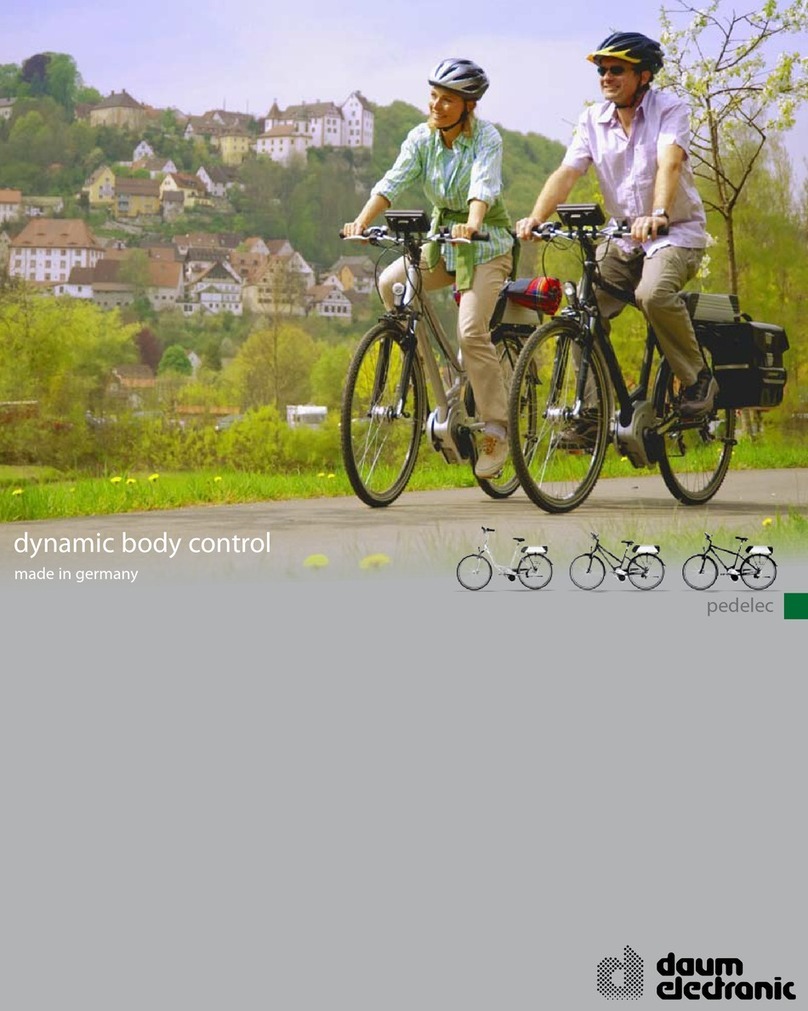
Daum electronic
Daum electronic pedelec Series manual
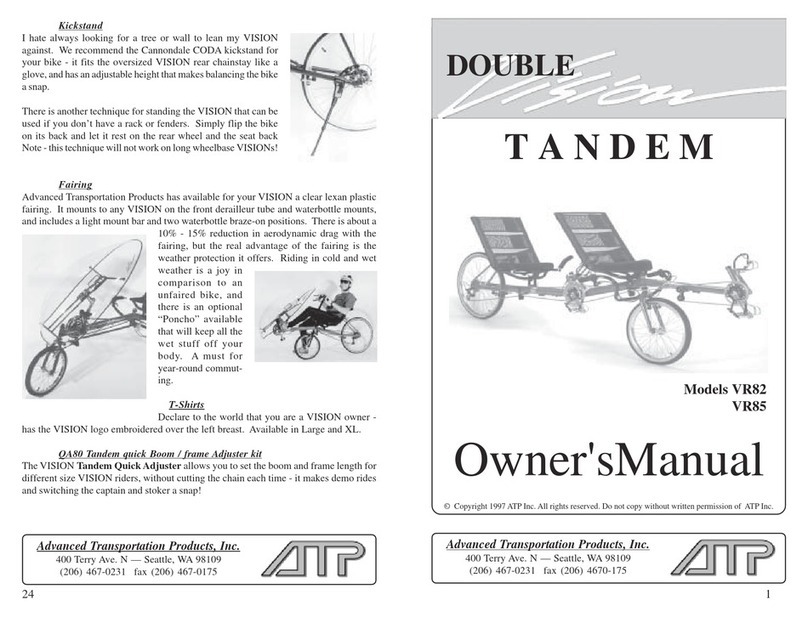
ATP Electronics
ATP Electronics VR82 Double Vision Tandem owner's manual

Nukeproof
Nukeproof MEGA 290 owner's manual

Prodeco Technologies
Prodeco Technologies Men's Fitness user guide
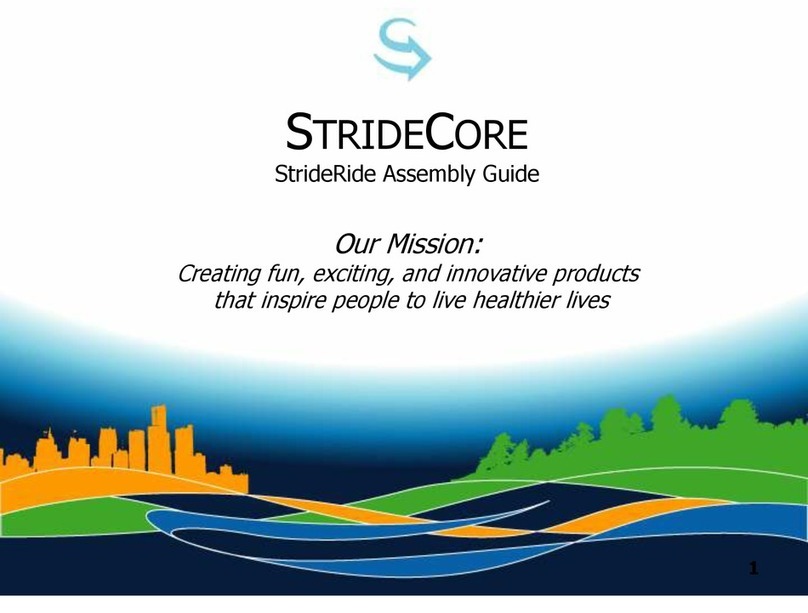
StrideCore
StrideCore StrideRide Assembly guide

CycloTricity
CycloTricity Stealth owner's manual
